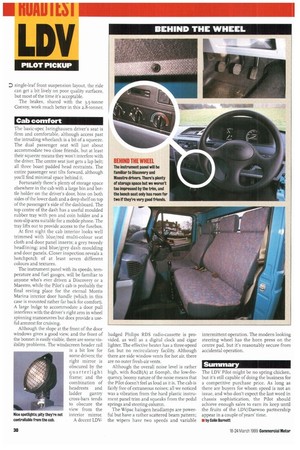LDV
Page 32

If you've noticed an error in this article please click here to report it so we can fix it.
Cab comfort
The basic-spec Isringhausen driver's seat is firm and comfortable, although access past the intruding wheelardi is a bit of a squeeze. The dual passenger seat will just about accommodate two close friends, but at least their squeeze means they won't interfere with the driver. The centre seat just gets a lap belt; all three boast padded head restraints. The entire passenger seat tilts forward, although you'll find minimal space behind it.
Fortunately there's plenty of storage space elsewhere in the cab with a large bin and bottle holder on the driver's door, bins on both sides of the lower dash and a deep shelf on top of the passenger's side of the dashboard. The top centre of the dash has a useful moulded rubber tray with pen and coin holder and a non-slip area suitable for a mobile phone. The tray lifts out to provide access to the fusebox.
At first sight the cab interior looks well trimmed with blue/red multi-colour seat cloth and door panel inserts; a grey tweedy headlining; and blue/grey dash moulding and door panels. Closer inspection reveals a hotchpotch of at least seven different colours and textures.
The instrument panel with its speedo, temperature and fuel gauges, will be familiar to anyone who's ever driven a Discovery or a Maestro, while the Pilot's cab is probably the final resting place for the eternal Morris Marina interior door handle (which in this case is mounted rather far back for comfort). A large bulge to accommodate a door pull interferes with the driver's right arm in wheel spinning manoeuvres but does provide a useful armrest for cruising.
Although the slope at the front of the door windows gives a good view, and the front of the bonnet is easily visible, there are some visibility problems. The windscreen header rail is a bit low for some drivers; the right mirror is obscured by the quarterlight frame; and the combination of headrests and ladder gantry cross-bars tends to obscure the view from the interior mirror.
A decent LDV
badged Philips RDS radio-cassette is provided, as well as a digital clock and cigar lighter. The effective heater has a three-speed fan but no recirculatory facility. Although there are side window vents for hot air, there are no outer fresh-air vents.
Although the overall noise level is rather high, with 8odB(A) at 60mph, the low-frequency, boomy nature of the noise means that the Pilot doesn't feel as loud as it is. The cab is fairly free of extraneous noises; all we noticed was a vibration from the hard plastic instrument panel trim and squeaks from the pedal springs and steering column.
The Wipac halogen headlamps are powerful but have a rather scattered beam pattern; the wipers have two speeds and variable intermittent operation. The modern looking steering wheel has the horn press on the centre pad, but it's reasonably secure from accidental operation.
Summary
The LDV Pilot might be no spring chicken, but it's still capable of doing the business for a competitive purchase price. As long as there are buyers for whom speed is not an issue, and who don't expect the last word in chassis sophistication, the Pilot should achieve enough sales to earn its keep until the fruits of the LDV/ Daewoo partnership appear in a couple of years' time.
• by Colin Barnett




















































































































